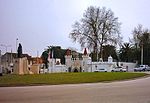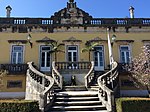Monastery of Santa Clara-a-Velha
Christian monasteries established in the 13th centuryChurches in Coimbra DistrictNational monuments in Coimbra DistrictPoor Clare monasteries in PortugalReligious buildings and structures completed in 1330 ... and 4 more
Roman Catholic churches in CoimbraRuined abbeys and monasteriesRuins in PortugalTourist attractions in Coimbra

The ruins of the Monastery of Santa Clara-a-Velha (Old St. Clare) are located in the city of Coimbra, in Portugal. The monastery was built in the 14th century on the left bank of the Mondego River, but had to be abandoned in the 17th century due to frequent floods. The well-preserved Gothic ruins of the monastery were excavated in the late 20th century, more than 300 years after being abandoned by the nuns. The ruined church recently reopened to the public after 12 years of restorations with a new visitor center.
Excerpt from the Wikipedia article Monastery of Santa Clara-a-Velha (License: CC BY-SA 3.0, Authors, Images).Monastery of Santa Clara-a-Velha
Rua de Baixo, Coimbra Santa Clara (Santa Clara e Castelo Viegas)
Geographical coordinates (GPS) Address Nearby Places Show on map
Geographical coordinates (GPS)
| Latitude | Longitude |
|---|---|
| N 40.202755555556 ° | E -8.4334388888889 ° |
Address
Mosteiro de Santa Clara-a-Velha
Rua de Baixo
3040-242 Coimbra, Santa Clara (Santa Clara e Castelo Viegas)
Portugal
Open on Google Maps









